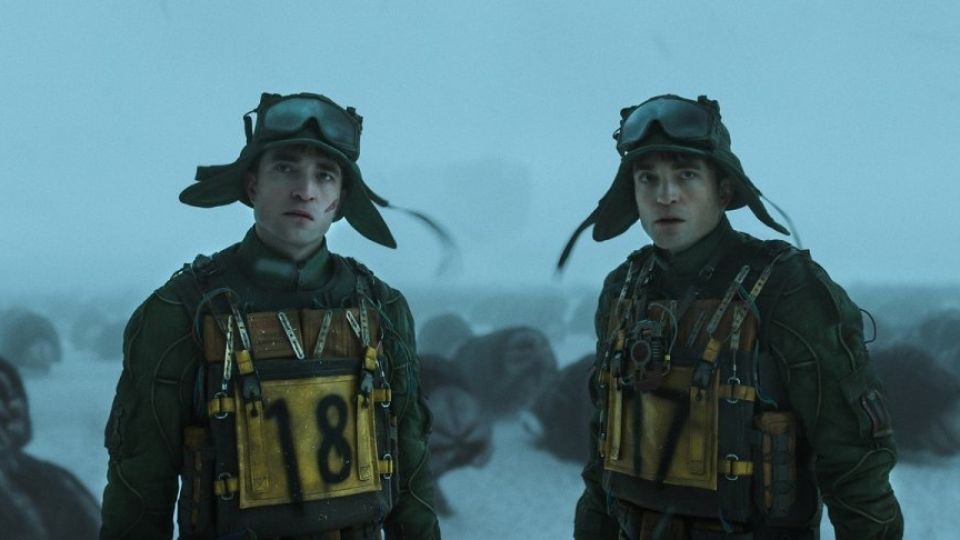February 19, 2025
SEOUL – Bong Joon-ho’s first film in six years performs a curious act of self-replication. Like its protagonist, an endlessly reproducible space colonist, “Mickey 17” copies the director’s familiar preoccupations while draining them of their animating force. The result is a $150 million big-budget exercise in diminishing returns.
The premise proclaims itself as quintessential Bong: Mickey Barnes (Robert Pattinson), fleeing Earth’s loan sharks, signs up as an “expendable” on a colonial mission to the ice planet Niflheim. His job is to die, repeatedly, while his consciousness gets downloaded into freshly printed bodies. When Mickey 17 improbably survives a deadly fall, he confronts his replacement, Mickey 18, setting in motion a conflict between identical selves.
What’s missing here isn’t Bong’s politics — his career-long interrogation of power relations remains intact — but rather the formal ingenuity that once made those politics sting. Where “Snowpiercer” weaponized its ingenious train-as-society metaphor and “Okja” delivered a visceral thrill in its chase, “Mickey 17” largely lets its questions float in midair. From ecological crisis to colonial exploitation, drug abuse to the myth of meritocracy, and even Foucauldian biopolitics in its calorie-controlled spaceship, each theme arrives with perfunctory efficiency and departs without resonance; they are narrative checkpoints with functions, not implications.
This emptiness flows directly from the metabolism of its storytelling. Each plot point drowns in lengthy exposition, delivered through Mickey’s nasal, disengaged voiceover, that simultaneously over-explains its mechanics while under-exploring its philosophical implications.
Are identical clones identical selves? Does disposable labor inevitably breed disposable consciousness? Is replicated humanity capitalism’s logical endpoint? These vital questions loom large within the film’s universe, where “multiples” remain a hotly contested phenomenon. Yet, the film chooses to skim past their weight.
When Mickey’s narration waves away clone-printing debates as “ethical fights and religious blah blah,” it signals not strategic evasion but a poverty of ideas. The pattern persists in Nasha (Naomi Ackie), the ship’s combat specialist and Mickey’s devoted lover, who greets her lover’s duplication by celebrating the prospect of more sex — a telling reduction of a metaphysical crisis to juvenile fantasy.
This feel-good approach defines not just the film’s philosophical reach but its ultimate destination — the director’s ethical vision writ large. For a film centered on expendable bodies and replicated consciousness, it settles too comfortably on affirming humanity’s innate worth. The climactic mass uprising, complete with preachy antiauthoritarian and anticolonial speeches about human dignity, trades the director’s signature narrative gamesmanship for manipulative didacticism. It’s a disappointing departure from Bong’s characteristically organic narratives, where showing is usually prioritized over telling.
Even Bong’s trademark black humor has lost the tartness of his Korean-language works, suggesting something vital was lost in translation. Mark Ruffalo embodies this deficiency as Kenneth Marshall, a failed politician-turned-space colony commander. At a recent Seoul press conference, Bong praised the character’s “unprecedented, cute charm” — but it turns out he has neither of those qualities. Ruffalo’s Marshall, with his crass rhetoric and kitschy swagger, brazenly channels Trump by way of SNL while lacking the layered menace that made the wealthy family in “Parasite” so effectively unsettling. Toni Collette’s Ylfa, the demagogue’s vain, sauce-obsessed wife wielding excessive influence over her husband, resonates pointedly with Korean viewers with their own presidential politics, yet never transcends mere caricature.
Retreating to blockbuster territory provides no salvation either, as the film’s attempts at spectacle feel recursive. Cinematographer Darius Khondji renders Niflheim in the same apocalyptic whites that blanketed “Snowpiercer,” while the indigenous Creepers — giant furry creatures with gaping maws — feel like genetic splices of superpig Okja and, from a more distant yet obvious source, the formidable Ohmu from Hayao Miyazaki’s “Nausicaa of the Valley of the Wind.”
Pattinson provides the film’s sole spark of genuine life, crafting through sheer performative force distinct personalities for his two Mickeys — one meek, one rebellious— while asserting their essential sameness. His Mickey 18 bristles with indignation at the casual cruelty shown to his predecessor, channeling the self-worth Mickey 17 never mustered. Through this fractured mirror of self-recognition, the film finds its rare moments of pathos.
The irony is unavoidable: In his first film since ascending to the pinnacle of global cinema with “Parasite,” Bong has produced something that mimicks its titular expendable protagonist — going through the motions of death and rebirth while losing something essential in each reproduction. His message of resistance persists, its optimism amplified but its disruptive edge dulled. Like the endless Mickeys churned out by the ship’s printer, this is Bong’s cinema with its consciousness intact but its body reduced to mere meat matrix.
“Mickey 17” opens Feb. 28 in theaters in Korea.


